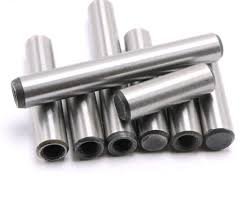Description
Internal threaded taper pins are specialized fasteners used in various applications to secure and align components with precision. These pins are designed to provide a reliable and durable assembly in situations where regular taper pins or straight pins may not be sufficient.
- Design and Construction:
Internal threaded taper pins as per ISO 8736 / EN 28 736 / IS 3524 (PART 1) / DIN 7978 are typically made from materials such as carbon steel, stainless steel, or alloy steel. They feature a tapered body with internal threads at one end along the length of the pin. The taper allows for easy insertion and removal.
- Tapered Body:
The tapered body of an internal threaded taper pin enables self-centering and self-locking properties when inserted into a hole or component with matching taper. The taper angle may vary depending on the specific application, but standard angles range are 1:48 for inches series and 1:50 for metric series.
- Internal Threads:
The Internal threads provide the means to extract the pins from blind holes where the assembly does not allow the feasibility to extract or knock the pin out from the other end. The threads are typically tapped or machine-cut with precision. The thread type and pitch can and mentioned in the standards ISO 8736 / EN 28 736 / IS 3524 (PART 1) / DIN 7978.
- Installation:
To install an internal threaded taper pin, a hole in the component/s is prepared by drilling and taper reaming operations. The pin is then inserted into the hole until it is fully seated. The taper design ensures that the pin tightens as it is driven deeper into the hole, providing a tight and secure fit.
- Benefits and Applications:
Internal threaded taper pins offer several advantages:
Reusability: Internal threaded taper pins can be easily removed and reused, making them a cost-effective fastening solution.
Applications for internal threaded taper pins:
These pins find applications in various industries, including automotive such as transmission assemblies, aerospace, machinery, in connecting and aligning gearboxes, motors, and other mechanical components or in dies, jigs, and fixtures and tooling, where precision and reliability are paramount.






Reviews
There are no reviews yet.